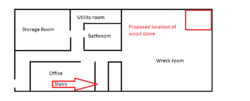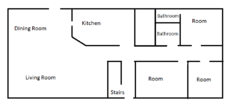Hello all....I have been contemplating installing a wood stove and chimney pipe in my house for the past year now. I have done lots of research on some stoves that I am interested in, and while researching found this forum that had lots of information. I figured I would join, and ask for some suggestions as this will be a big purchase (stove, chimney pipe, hearth pad) and I do not want waste money.
I live in a split foyer home that is 1920 sq. feet. My only current source of heat is central air via heat pump, which I am sure everyone knows can run the electric bill up in the winter time. I love wood stoves, and I am not afraid of physical labor to save money on heating.
I have been looking at the Englander NC30, as well as the Woodpro WS-TS-2000. I am looking to heat a majority of the house. My idea was to place it in the basement, however the only good location to put it is in the back right corner of the house in the walk out portion of the basement. I am also thinking on a budget as well, as I am sure most people do. I am trying to figure out if either of these stoves would be a good idea or am I not looking at the right kind.
Thanks for your time!
I live in a split foyer home that is 1920 sq. feet. My only current source of heat is central air via heat pump, which I am sure everyone knows can run the electric bill up in the winter time. I love wood stoves, and I am not afraid of physical labor to save money on heating.
I have been looking at the Englander NC30, as well as the Woodpro WS-TS-2000. I am looking to heat a majority of the house. My idea was to place it in the basement, however the only good location to put it is in the back right corner of the house in the walk out portion of the basement. I am also thinking on a budget as well, as I am sure most people do. I am trying to figure out if either of these stoves would be a good idea or am I not looking at the right kind.
Thanks for your time!



